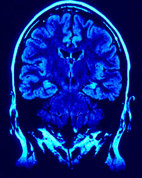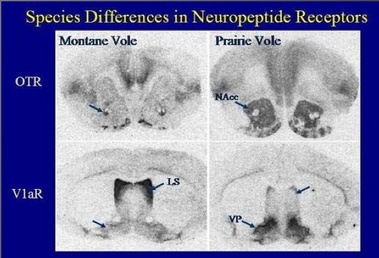What Neuroscience Tells Us About Morality

Dr. Churchland, a professor at UC San Diego,discussed morality, its neural platform, and its origins in mammalian brain evolution at the Natural History Museum. We had the opportunity to attend her lecture and get a better understanding of why animals do certain things and have certain morals. We learned what influences morality and how biochemically, morality can be determined. One of the main things that Dr. Churchland discussed was why certain animals mate with others and have babies, only to never see them again. They follow a continuous path of mating with different animals and then moving on. The animals almost live a life of lust and the morals that humans have are clearly absent in the brains of some mammals. So what causes this? While you think attaining morals is a psychological and personal decision, it really all depends on the biochemical makeup of your brain.
Oxytocin
Oxytocin is the chemical that really determines morality. In the brain, oxytocin is involved in social recognition and bonding, and may be involved in the formation of trust between people and generosity. All humans have it as do many mammals, but there are some species that lack it. Oxytocin is secreted from the pituitary gland can;t re-enter the brain because of the blood-brain barrier. The behavioral effects of oxytocin are thought to reflect release from centrally projecting oxytocin neurons, different from those that project to the pituitary gland. Oxytocin receptors are expressed by neurons in many parts of the brain and spinal cord.
Actions of Oxytocin Within the Brain Oxytocin causes sexual arousal and desires. In the female, desires to mate and bond are triggered by oxytocin, while in the male, vasopressin is the chemical that causes this in males. Levels of oxytocin and vasopressin are higher in people who claim to be falling in love. Studies were done with autistic people exhibiting that the levels of oxytocin were significantly lower then usual. With intravenous injections of oxytocin, the repetitive behaviors of autistic children decrease. Also, intravenous injections help autistic adults to analyze tone of voice. Increasing and decreasing levels of oxytocin also affect the behavior of mothers. With the antagonist dejection of oxytocin, mothers do not display the same maternal actions that they would have otherwise. High levels of oxytocin increases trust and reduces fear. It also affects generosity by increasing empathy.
Actions of Oxytocin Within the Brain Oxytocin causes sexual arousal and desires. In the female, desires to mate and bond are triggered by oxytocin, while in the male, vasopressin is the chemical that causes this in males. Levels of oxytocin and vasopressin are higher in people who claim to be falling in love. Studies were done with autistic people exhibiting that the levels of oxytocin were significantly lower then usual. With intravenous injections of oxytocin, the repetitive behaviors of autistic children decrease. Also, intravenous injections help autistic adults to analyze tone of voice. Increasing and decreasing levels of oxytocin also affect the behavior of mothers. With the antagonist dejection of oxytocin, mothers do not display the same maternal actions that they would have otherwise. High levels of oxytocin increases trust and reduces fear. It also affects generosity by increasing empathy.
Morality
Dr. Churchland discussed where values, social behavior, and morality comes from. She stated that the two main areas are cultural, and biological. The biological emphasis is what really makes culture possible.
Biology
Biological capacity to be part of Culture
platform that creates the superstructure of culture
Genetic makeup
Evolutionary background
Chemical makeup
platform that creates the superstructure of culture
Genetic makeup
Evolutionary background
Chemical makeup
Culture
Institutions
Attachment and trust
Conventions
Being together
Nurturing
Environment
Attachment and trust
Conventions
Being together
Nurturing
Environment
Paul McClean, made some observations about mammals. Some animals nurse their babies and play with them while frogs for example, have their babies and move on. "The history of the evolution of mammals is the history of the development of the family way of life." Some animals are born dependent and immature. All mammals need mothering, therefore their had to be some sort of rewiring of the female brain to give her the mental capacity to care for her young. All vertebrates have Oxytocin and Vasopressin. In the mammalian brain, Oxytocin and vasopressin are crucial in materializing the brain. For certain animals sociability is a value. The frontal structure are critical for self control and maintaining balance in a social situation. Where do values come from?
All animals have circuitry to see to their own well being. They all have the capacity to maintain their own homeostatic variables. The brain stem has the means to set priorities. The brain stem embodies the fundamental values of well being, but also the emotional prioritizing and rational. The homeostatic value of wellfare extends to the offspring with expansion of the prefrontal skull. Somewhere along the lines, the brain materialized and influenced the brain to not only care about the individual wellbeing, but to include others in priorities. Oxytocin is released in the brain during nurturing and it builds the relationship between the mother and her kin. A baby rat for example, is nursed, cuddled, and fed by it's mother. The level of Oxytocin present in a nurtured rat's brain is significantly higher than the Oxytocin level of a healthy rat that was separated from it's mother at birth.
All animals have circuitry to see to their own well being. They all have the capacity to maintain their own homeostatic variables. The brain stem has the means to set priorities. The brain stem embodies the fundamental values of well being, but also the emotional prioritizing and rational. The homeostatic value of wellfare extends to the offspring with expansion of the prefrontal skull. Somewhere along the lines, the brain materialized and influenced the brain to not only care about the individual wellbeing, but to include others in priorities. Oxytocin is released in the brain during nurturing and it builds the relationship between the mother and her kin. A baby rat for example, is nursed, cuddled, and fed by it's mother. The level of Oxytocin present in a nurtured rat's brain is significantly higher than the Oxytocin level of a healthy rat that was separated from it's mother at birth.
Voles

Dr. Churchland talked about the presence of Oxytocin in two different species of voles. The study done with vole detected that even animals of the same species have different levels of morality and concluding, different levels of Oxytocin. Attachment and trust are the basic platforms of moral values. The two species are so similar, how could their values be so different? A remarkable discovery was made in examining the pictures of these two male voles. While with both voles, oxytocin was present, in two specific areas the Prairie vole's level of Oxytocin was significantly higher, making it a much more emotional, sensitive and sentimental animal than the Montagne vole. The influence of the chemical of Oxytocin in just two small areas drastically changed the behavior of the Voles. Studies showed just how critical Oxytocin really is. Long term pair bonding is really determined in a biological way.
Praire Voles
Live in the Prairies
After the first mating, they were bonded for life
hang out together
caring
male helps take care of the pups
The density of receptors were higher in specific areas
comfortable
After the first mating, they were bonded for life
hang out together
caring
male helps take care of the pups
The density of receptors were higher in specific areas
comfortable
Montane Voles
Live among the rocks and shrubs
typical rodent
permiscuous
insensitive
mates with many different voles
The density of receptors were lower in specific areas
fearful
typical rodent
permiscuous
insensitive
mates with many different voles
The density of receptors were lower in specific areas
fearful
Through attending the lecture and further study, we have come to the realization that morality is greatly influenced by the biochemical makeup of ones brain. Through studies done with various species, scientists have concluded that mammals with high levels of oxytocin are more compassionate, sensitive, and most of all, moral.
http://psychcentral.com/lib/2008/about-oxytocin/

